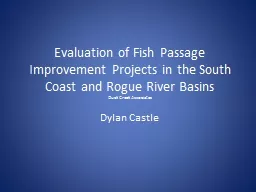

Duck Creek Associates Dylan Castle Overview Purpose of Surveys Types of Projects Surveyed Methods of Evaluation Results Discussion Surveyed Sites Conclusion Purpose Contracted by OWEB to evaluate various fish passage enhancement projects 2009 ID: 228201
Download Presentation The PPT/PDF document "Evaluation of Fish Passage Improvement P..." is the property of its rightful owner. Permission is granted to download and print the materials on this web site for personal, non-commercial use only, and to display it on your personal computer provided you do not modify the materials and that you retain all copyright notices contained in the materials. By downloading content from our website, you accept the terms of this agreement.
Slide1
Evaluation of Fish Passage Improvement Projects in the South Coast and Rogue River BasinsDuck Creek Associates
Dylan CastleSlide2
OverviewPurpose of SurveysTypes of Projects Surveyed
Methods of Evaluation
Results
Discussion
Surveyed Sites
ConclusionSlide3
PurposeContracted by OWEB to evaluate various fish passage enhancement projects (2009)
Projects were carried out from 1992-2001
Field assessments at 64 project sites
Objective 1; determine if fish passage improvement projects provided adequate passage
Objective 2; determine if juvenile salmonids utilize habitat above the projects.Slide4
Study AreaSlide5
Types of ProjectsReplacing existing non-functional culverts and dams
Bridges
Stream simulated culverts
Culverts with baffles
Fish laddersSlide6
Types of Culverts
Concrete Culvert
Corrugated Steel Culvert
Open Arch Culvert
Flat-Bottom CulvertSlide7
MethodsCulverts
Longitudinal Survey for morphology and gradient
Typically 30-35m above and below area
Culvert Dimensions
Substrate size of channel and size within culvert
Water Velocity before, in, and after culvertSlide8
Methods
Bridges
Longitudinal profile
Dimensions of bridge
Material
Channel Substrate
Fish Screens
Keep fish from
entering irrigation ditches
Snorkeling
Pools upstream within 135m of site
Weather,
visibility, depth, width, and lengthSlide9
FishXingsSoftware Package used to design and assess culverts for fish passage
Built-in information about fish species
Speed, jumping, swimming strength, and other abilities
Provides range of discharge rates that a particular fish could pass through a culvertSlide10
Results42 Culverts, 14 Bridges, and 8 other projects
Juvenile salmon present in majority of sites
Lack of habitat, pools, and flowing water noted in cases where juveniles were missing
Some sites were unknown due to water visibilitySlide11
Results
FishXings
Data
16 rated impassable by velocity
3 impassable by velocity and outlet drop
Rest considered passable
through
varying flow rates
Note: 13 sites had juveniles upstream of site deemed 100% impassable by
FishXingsSlide12
Discussion84% of sites showed juvenile salmonids
Passage at culverts limited to small percent of flow rates
Most passable flow rates occur during times of salmon migration
20 culverts designed specifically for salmonids were predicted to be barriers
These predicted barriers had salmonids upstream
May not have migrated through culvert.Slide13Slide14
Site #26
20-50 year old alders and conifers
Skunk cabbage, salmon berry and bulrush
Silt, gravel, and boulders
0.1% passable flows
No substrate in culvert, velocity barrierSlide15
Site #29
Channel substrate 100% silt
Channel confined to dredged ditch
4% passable flows, velocity barrierSlide16
Site 31
Channelized, incised, and lined with rip-rap
Impacted by agriculture
Silt, cobbles, gravel, and boulders
6% passable flows, velocity barrierSlide17
Site # 82
Excellent spawning gravels
Many small pools
Inside managed forest
100% block to juveniles by
FishXings
Salmonids still found in poolsSlide18
Site 66
Downtown Ashland
Bridge site
Boulders, cobbles, and gravels
Creek was not snorkeled, but juveniles were observed
Boulders artificially placedSlide19
ConclusionObjective 1; determine if fish passage improvement projects provided adequate passage
Objective 2; determine if juvenile salmonids utilize habitat above the projects.
Replacing existing non-functional culverts and dams
Longitudinal surveys of site areas.
Juveniles observed in 82% of sites
Salmonids can flourish in a variety of areas with proper care of habitat and water.